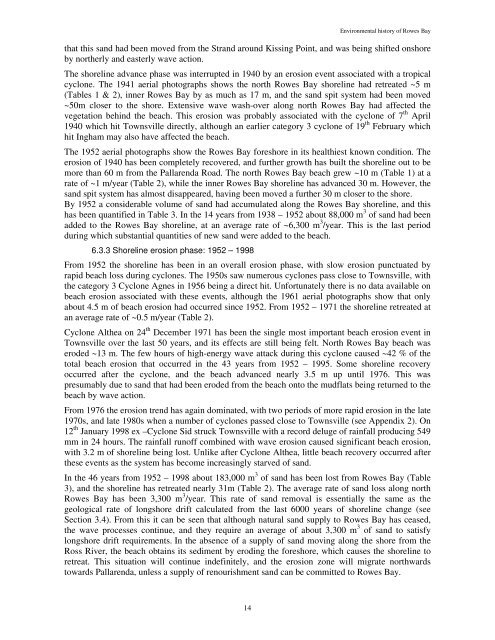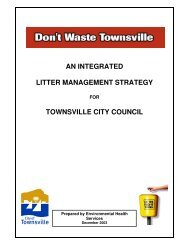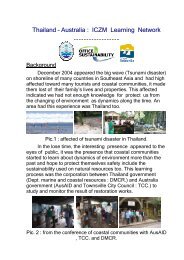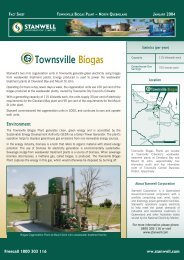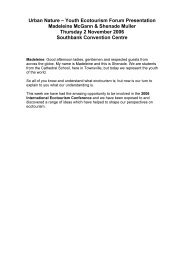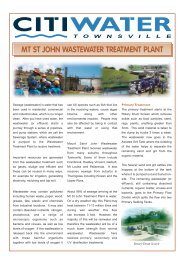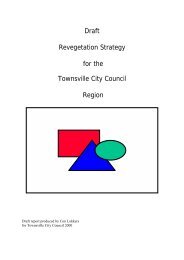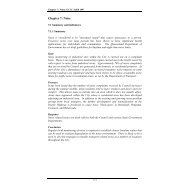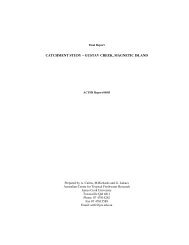ENVI RONMENTAL HI STORY OF ROWES BAY - Townsville State ...
ENVI RONMENTAL HI STORY OF ROWES BAY - Townsville State ...
ENVI RONMENTAL HI STORY OF ROWES BAY - Townsville State ...
- No tags were found...
Create successful ePaper yourself
Turn your PDF publications into a flip-book with our unique Google optimized e-Paper software.
Environmental history of Rowes Baythat this sand had been moved from the Strand around Kissing Point, and was being shifted onshoreby northerly and easterly wave action.The shoreline advance phase was interrupted in 1940 by an erosion event associated with a tropicalcyclone. The 1941 aerial photographs shows the north Rowes Bay shoreline had retreated ~5 m(Tables 1 & 2), inner Rowes Bay by as much as 17 m, and the sand spit system had been moved~50m closer to the shore. Extensive wave wash-over along north Rowes Bay had affected thevegetation behind the beach. This erosion was probably associated with the cyclone of 7 th April1940 which hit <strong>Townsville</strong> directly, although an earlier category 3 cyclone of 19 th February whichhit Ingham may also have affected the beach.The 1952 aerial photographs show the Rowes Bay foreshore in its healthiest known condition. Theerosion of 1940 has been completely recovered, and further growth has built the shoreline out to bemore than 60 m from the Pallarenda Road. The north Rowes Bay beach grew ~10 m (Table 1) at arate of ~1 m/year (Table 2), while the inner Rowes Bay shoreline has advanced 30 m. However, thesand spit system has almost disappeared, having been moved a further 30 m closer to the shore.By 1952 a considerable volume of sand had accumulated along the Rowes Bay shoreline, and thishas been quantified in Table 3. In the 14 years from 1938 – 1952 about 88,000 m 3 of sand had beenadded to the Rowes Bay shoreline, at an average rate of ~6,300 m 3 /year. This is the last periodduring which substantial quantities of new sand were added to the beach.6.3.3 Shoreline erosion phase: 1952 – 1998From 1952 the shoreline has been in an overall erosion phase, with slow erosion punctuated byrapid beach loss during cyclones. The 1950s saw numerous cyclones pass close to <strong>Townsville</strong>, withthe category 3 Cyclone Agnes in 1956 being a direct hit. Unfortunately there is no data available onbeach erosion associated with these events, although the 1961 aerial photographs show that onlyabout 4.5 m of beach erosion had occurred since 1952. From 1952 – 1971 the shoreline retreated atan average rate of ~0.5 m/year (Table 2).Cyclone Althea on 24 th December 1971 has been the single most important beach erosion event in<strong>Townsville</strong> over the last 50 years, and its effects are still being felt. North Rowes Bay beach waseroded ~13 m. The few hours of high-energy wave attack during this cyclone caused ~42 % of thetotal beach erosion that occurred in the 43 years from 1952 – 1995. Some shoreline recoveryoccurred after the cyclone, and the beach advanced nearly 3.5 m up until 1976. This waspresumably due to sand that had been eroded from the beach onto the mudflats being returned to thebeach by wave action.From 1976 the erosion trend has again dominated, with two periods of more rapid erosion in the late1970s, and late 1980s when a number of cyclones passed close to <strong>Townsville</strong> (see Appendix 2). On12 th January 1998 ex –Cyclone Sid struck <strong>Townsville</strong> with a record deluge of rainfall producing 549mm in 24 hours. The rainfall runoff combined with wave erosion caused significant beach erosion,with 3.2 m of shoreline being lost. Unlike after Cyclone Althea, little beach recovery occurred afterthese events as the system has become increasingly starved of sand.In the 46 years from 1952 – 1998 about 183,000 m 3 of sand has been lost from Rowes Bay (Table3), and the shoreline has retreated nearly 31m (Table 2). The average rate of sand loss along northRowes Bay has been 3,300 m 3 /year. This rate of sand removal is essentially the same as thegeological rate of longshore drift calculated from the last 6000 years of shoreline change (seeSection 3.4). From this it can be seen that although natural sand supply to Rowes Bay has ceased,the wave processes continue, and they require an average of about 3,300 m 3 of sand to satisfylongshore drift requirements. In the absence of a supply of sand moving along the shore from theRoss River, the beach obtains its sediment by eroding the foreshore, which causes the shoreline toretreat. This situation will continue indefinitely, and the erosion zone will migrate northwardstowards Pallarenda, unless a supply of renourishment sand can be committed to Rowes Bay.14


